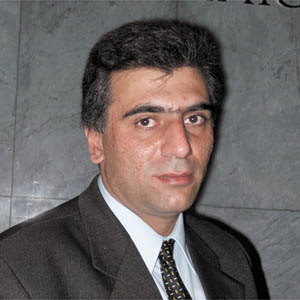Chris Tozlian
staff writer
Most Armenians feel some sort of tie to Armenia. They look at it as their place of birth, even if they have never set foot on its soil or gazed at Mount Ararat standing just beyond the border of Armenia. They see it as the setting of their history and they feel a sense of gratitude to this geographic area that once provided for their ancestors. They take pride in this place that once housed mighty rulers like Dickran II (the Great) and Christian martyrs such as Vartan Mamigonian. Because of this sense of pride, many Armenians ponder the current welfare of this nation that they owe so much to, which has only had an independent government since 1991.
On Thursday, Feb. 28, Armenians in the Fresno area were able to hear first-hand about the status of their homeland, as professors Armen Yeghiazaryan, Narek Martirosyan, and Alexander Chilingaryan spoke at CSU Fresno to a large audience about the current economic conditions in Armenia.
These three professors all teach at Yerevan State University (YSU) but visited Fresno recently as part of a project that brings together CSU Fresno and YSU; the goal of this project is to implement new curriculum and teaching techniques at YSU. The expected result is better-trained and better-prepared business students who will be ready for the “real world” when they are placed in the business sector of Armenia.
The speakers each focused on a different aspect of Armenia’s economy: foreign investment within Armenia; the financial deficit of the Armenian government; and personnel management (human resource management) within Armenian businesses.

The first to speak was Professor Armen Yeghiazaryan, who spoke about foreign investment taking place within Armenia. He began by pointing out that foreign investment within Armenia is currently $45 per capita, while most other former Soviet Union nations sit somewhere around $20 per capita; conversely, this $45 mark compares rather poorly to oil-rich Arab nations that have foreign investment at approximately $75 per capita. Still, foreign investment within Armenia is growing and is greater than the foreign investment entering Armenia’s surrounding nations.
Yeghiazaryan went on to concisely explain both the problems and the benefits that were related to foreign investment in Armenia. First, he explained the problems that investors faced, such as Armenia’s small market, comprised largely of poverty-stricken people. Government corruption and meddlesome government agencies also work as deterrents to foreign investment; frustrated relations between Armenia and some of its neighboring countries have also caused potential investors to question Armenia as the site for their investments. However, Professor Yeghiazaryan also explained that Armenia had a certain attraction to potential investors, such as the population’s high level of education and desire to work. He also mentioned the relatively low rate of inflation and the stable exchange rate as being incentives for foreign investors.

Next, Professor Martirosyan spoke concerning Armenia’s financial debt, which has risen each year. While this does not seem to be an indicator of governmental stability, further examination of the statistics is necessary. From 1992 to 1993, there was more than an 80% increase in the government deficit, while from 1999 to 2000, there was less than a four percent deficit increase. Because the GDP has been rising so rapidly in the past few fiscal years, Professor Martirosyan predicts greater financial growth in Armenia. He added that the continued deficits in past years have been a result of the Karabagh wars and difficulties in the government collecting all their taxes. However, as industry continues to grow and peace is sought out, the annual deficit should continue to shrink smaller and smaller until it is no more.
Finally,Professor Chilingaryan spoke, explaining that personnel management is given little attention in Armenia, which is quite contrary to the American style of business. Managers in Armenia still do not fully understand and embrace the importance of personnel management, partially because of past Soviet influence on business. Also, during this transition period from government-run businesses to privately-run businesses, no formal theory has smoothly guided the change.

The uncertain and ever-changing economic environment, that is the Armenian economy, has made the institution of personnel management relatively difficult. Armenian universities are only now making the transition to properly train and mold the managers of tomorrow’s economy. For these reasons, personnel management is struggling in Armenia; however, the first step toward solving this problem is acknowledging the problem. This acknowledgment came years ago, and faculty at YSU are looking for ways to correct inefficient business practices in Armenia.
Though it may seem a bit disheartening to think of the trials facing the Armenian economy, each professor pointed out that the Armenian economy is growing and has the ability to become strong and stable. As foreign investment grows and the GDP continues to rise, this will push down the deficit that many are concerned with. This will necessitate more competent managers to lead groups of workers efficiently. Ultimately, the lecture proved to be a message of hope to all who attended; though things may look bleak now, the Armenian economy is on the rise.
The lecture was sponsored by the Armenian Studies Program and Armenian Students Organization.
 Hye Sharzhoom Armenian Action
Hye Sharzhoom Armenian Action